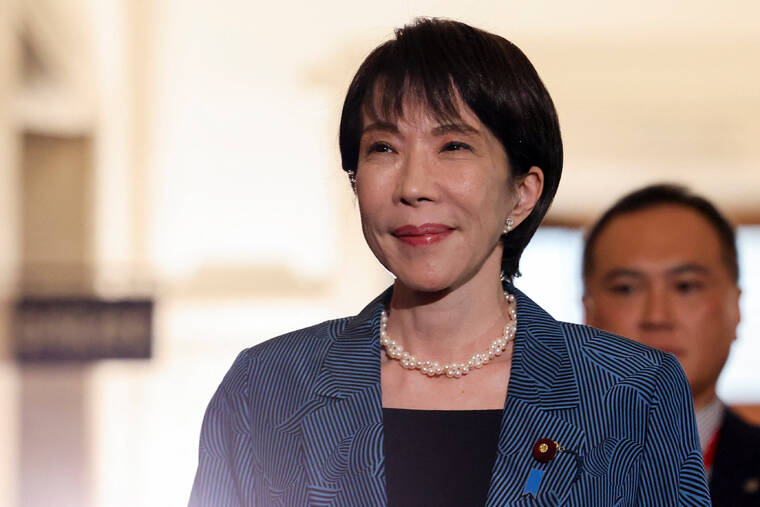World
Japan Elects Sanae Takaichi as First Female Prime Minister

On October 21, 2023, Japan made history as Sanae Takaichi secured the position of the nation’s first female prime minister, receiving 237 votes in the lower house election. Takaichi, president of the Liberal Democratic Party (LDP), surpassed the required majority by four votes. In a statement, she vowed to “work boldly without fear of change,” igniting hopes among supporters and women across the country for a transformative era in Japanese politics.
A New Era for Women in Leadership
The election of Takaichi has been hailed as a significant step forward for women’s advancement in Japan. “A woman has become the top leader,” said Osamu Kikuchi, chairman of an association of Takaichi’s supporters, who celebrated this milestone in his hometown of Yamatokoriyama City, Nara. “This could be a chance to change Japan, where there’s a lingering sense of stagnation.”
Takaichi’s ascent follows the attempts of several prominent female politicians, including Yuriko Koike, the former governor of Tokyo, and Seiko Noda, a former internal affairs minister, who previously vied for leadership positions within the LDP. Takaichi’s victory marks her third attempt at the LDP presidency since 2021, placing Japan among the ranks of the fifth Group of Seven (G7) nations to elect a female head of government, joining the likes of Britain, Canada, Germany, and Italy.
Koike congratulated Takaichi, expressing optimism about her leadership and its potential impact on women’s issues. “I have high hopes for her, including in terms of women’s advancement,” Koike stated.
Challenges Ahead for Gender Representation
As prime minister, Takaichi has appointed only two women to her Cabinet: Satsuki Katayama as finance minister and Kimi Onoda as economic security minister. Currently, women represent just 15.5% of lawmakers in Japan’s House of Representatives and 29.8% in the House of Councillors. According to data from the Inter-Parliamentary Union, Japan ranks 141st out of approximately 190 countries in terms of female representation in its lower house.
In a noteworthy move, in 2020, Sayo Homme, a member of the Taito Ward Assembly and director of the organization Woman Shift, submitted a request to Takaichi, then serving as internal affairs minister, advocating for women to be allowed to retain their maiden names when running for election. The ministry subsequently issued a notice to local governments, facilitating this change.
“Takaichi understands the hardships faced by female lawmakers,” said Homme, now 43. “We hope she will advance reforms that make it easier for female lawmakers to work.”
During her candidacy announcement, Takaichi shared personal experiences, revealing that she began facing menopausal symptoms in her forties. She noted that Japan has not adequately addressed women’s health issues, expressing a desire to promote relevant measures. Her physician commented on this revelation, stating, “I hope she will bring about systems that enable Japanese women to live comfortable and fulfilling lives.”
Symbol of Change?
While Takaichi’s rise to the premiership is indeed a significant milestone, opinions vary on whether she will serve as a role model for women in politics. Kiriu Minashita, a professor of gender studies at Kokugakuin University, remarked, “Takaichi has risen to the top by adapting to a male-dominated political culture, so it’s difficult to say if she will become a role model for many women.” Nonetheless, she emphasized the symbolic nature of Takaichi’s election and its potential to influence societal gender awareness moving forward. “I hope she will be able to execute policies,” Minashita added.
The election of Sanae Takaichi as Japan’s first female prime minister marks a pivotal moment in the nation’s political landscape. As she embarks on her new role, the expectations from supporters and advocates for women’s rights are high, and the path ahead is both promising and fraught with challenges.
-

 Politics1 week ago
Politics1 week agoHamas Chief Stresses Disarmament Tied to Occupation’s End
-

 Science1 week ago
Science1 week agoOhio State Study Uncovers Brain Connectivity and Function Links
-

 Science3 weeks ago
Science3 weeks agoResearchers Challenge 200-Year-Old Physics Principle with Atomic Engines
-

 Entertainment1 week ago
Entertainment1 week agoMegan Thee Stallion Exposes Alleged Online Attack by Bots
-

 Top Stories2 weeks ago
Top Stories2 weeks agoFederal Agents Detain Driver in Addison; Protests Erupt Immediately
-

 Top Stories2 weeks ago
Top Stories2 weeks agoOrioles Hire Craig Albernaz as New Manager Amid Rebuild
-

 Entertainment2 weeks ago
Entertainment2 weeks agoSyracuse Stage Delivers Lively Adaptation of ‘The 39 Steps’
-

 World3 weeks ago
World3 weeks agoGlobal Military Spending: Air Forces Ranked by Budget and Capability
-

 Top Stories2 weeks ago
Top Stories2 weeks agoWill Smith Powers Dodgers to World Series Tie with Key Homer
-

 Politics3 weeks ago
Politics3 weeks agoNHP Foundation Secures Land for 158 Affordable Apartments in Denver
-

 Business1 week ago
Business1 week agoHome Depot Slashes Prices on Halloween Favorites Up to 75%
-

 Lifestyle2 weeks ago
Lifestyle2 weeks agoTrump’s Push to Censor National Parks Faces Growing Backlash









